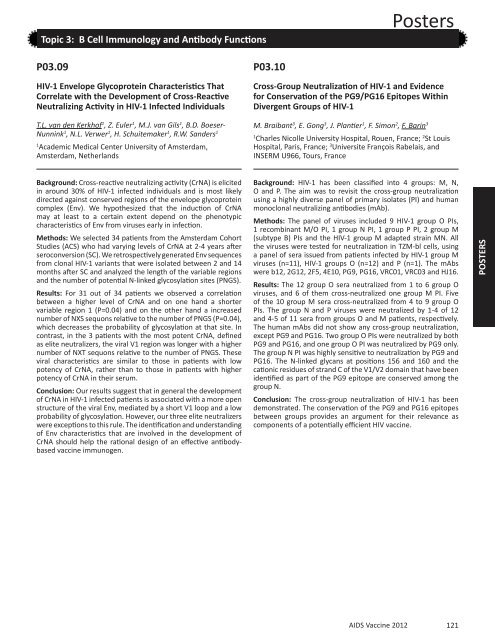Oral Abstract Session 01 - Global HIV Vaccine Enterprise
Oral Abstract Session 01 - Global HIV Vaccine Enterprise
Oral Abstract Session 01 - Global HIV Vaccine Enterprise
You also want an ePaper? Increase the reach of your titles
YUMPU automatically turns print PDFs into web optimized ePapers that Google loves.
Topic 3: B Cell Immunology and Antibody Functions<br />
P03.09<br />
<strong>HIV</strong>-1 Envelope Glycoprotein Characteristics That<br />
Correlate with the Development of Cross-Reactive<br />
Neutralizing Activity in <strong>HIV</strong>-1 Infected Individuals<br />
T.L. van den Kerkhof 1 , Z. Euler 1 , M.J. van Gils 1 , B.D. Boeser-<br />
Nunnink 1 , N.L. Verwer 1 , H. Schuitemaker 1 , R.W. Sanders 1<br />
1 Academic Medical Center University of Amsterdam,<br />
Amsterdam, Netherlands<br />
Background: Cross-reactive neutralizing activity (CrNA) is elicited<br />
in around 30% of <strong>HIV</strong>-1 infected individuals and is most likely<br />
directed against conserved regions of the envelope glycoprotein<br />
complex (Env). We hypothesized that the induction of CrNA<br />
may at least to a certain extent depend on the phenotypic<br />
characteristics of Env from viruses early in infection.<br />
Methods: We selected 34 patients from the Amsterdam Cohort<br />
Studies (ACS) who had varying levels of CrNA at 2-4 years after<br />
seroconversion (SC). We retrospectively generated Env sequences<br />
from clonal <strong>HIV</strong>-1 variants that were isolated between 2 and 14<br />
months after SC and analyzed the length of the variable regions<br />
and the number of potential N-linked glycosylation sites (PNGS).<br />
Results: For 31 out of 34 patients we observed a correlation<br />
between a higher level of CrNA and on one hand a shorter<br />
variable region 1 (P=0.04) and on the other hand a increased<br />
number of NXS sequons relative to the number of PNGS (P=0.04),<br />
which decreases the probability of glycosylation at that site. In<br />
contrast, in the 3 patients with the most potent CrNA, defined<br />
as elite neutralizers, the viral V1 region was longer with a higher<br />
number of NXT sequons relative to the number of PNGS. These<br />
viral characteristics are similar to those in patients with low<br />
potency of CrNA, rather than to those in patients with higher<br />
potency of CrNA in their serum.<br />
Conclusion: Our results suggest that in general the development<br />
of CrNA in <strong>HIV</strong>-1 infected patients is associated with a more open<br />
structure of the viral Env, mediated by a short V1 loop and a low<br />
probability of glycosylation. However, our three elite neutralizers<br />
were exceptions to this rule. The identification and understanding<br />
of Env characteristics that are involved in the development of<br />
CrNA should help the rational design of an effective antibodybased<br />
vaccine immunogen.<br />
P03.10<br />
AIDS <strong>Vaccine</strong> 2<strong>01</strong>2<br />
Posters<br />
Cross-Group Neutralization of <strong>HIV</strong>-1 and Evidence<br />
for Conservation of the PG9/PG16 Epitopes Within<br />
Divergent Groups of <strong>HIV</strong>-1<br />
M. Braibant 3 , E. Gong 3 , J. Plantier 1 , F. Simon 2 , F. Barin 3<br />
1 Charles Nicolle University Hospital, Rouen, France; 2 St Louis<br />
Hospital, Paris, France; 3 Universite François Rabelais, and<br />
INSERM U966, Tours, France<br />
Background: <strong>HIV</strong>-1 has been classified into 4 groups: M, N,<br />
O and P. The aim was to revisit the cross-group neutralization<br />
using a highly diverse panel of primary isolates (PI) and human<br />
monoclonal neutralizing antibodies (mAb).<br />
Methods: The panel of viruses included 9 <strong>HIV</strong>-1 group O PIs,<br />
1 recombinant M/O PI, 1 group N PI, 1 group P PI, 2 group M<br />
(subtype B) PIs and the <strong>HIV</strong>-1 group M adapted strain MN. All<br />
the viruses were tested for neutralization in TZM-bl cells, using<br />
a panel of sera issued from patients infected by <strong>HIV</strong>-1 group M<br />
viruses (n=11), <strong>HIV</strong>-1 groups O (n=12) and P (n=1). The mAbs<br />
were b12, 2G12, 2F5, 4E10, PG9, PG16, VRC<strong>01</strong>, VRC03 and HJ16.<br />
Results: The 12 group O sera neutralized from 1 to 6 group O<br />
viruses, and 6 of them cross-neutralized one group M PI. Five<br />
of the 10 group M sera cross-neutralized from 4 to 9 group O<br />
PIs. The group N and P viruses were neutralized by 1-4 of 12<br />
and 4-5 of 11 sera from groups O and M patients, respectively.<br />
The human mAbs did not show any cross-group neutralization,<br />
except PG9 and PG16. Two group O PIs were neutralized by both<br />
PG9 and PG16, and one group O PI was neutralized by PG9 only.<br />
The group N PI was highly sensitive to neutralization by PG9 and<br />
PG16. The N-linked glycans at positions 156 and 160 and the<br />
cationic residues of strand C of the V1/V2 domain that have been<br />
identified as part of the PG9 epitope are conserved among the<br />
group N.<br />
Conclusion: The cross-group neutralization of <strong>HIV</strong>-1 has been<br />
demonstrated. The conservation of the PG9 and PG16 epitopes<br />
between groups provides an argument for their relevance as<br />
components of a potentially efficient <strong>HIV</strong> vaccine.<br />
121<br />
POSTERS


